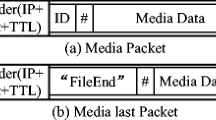Abstract
Video streaming over peer-to-peer (P2P) networks is a promising approach for scalable IPTV and online games. Distributing high-quality videos among users who employ numerous channels in multi-channel P2P live streaming systems, however, still suffers from many challenges arisen from the network size and dynamicity, channel resource imbalance, and bandwidth limitations. Other challenges also exist, including instability of peers, the peers’ low participation, large startup and playback delays, low quality of received video, and resource insufficiency in unpopular channels. In this paper, ReDePoly, with some levels of distributed intelligence, is proposed to reduce the bootstrapping delay and to increase the service quality. The key idea is to substitute agents with bootstrapping peers in the channels to model user behaviors and to share the aggregated knowledge among the agents to disseminate the learned models. Accordingly, the agents dynamically predict the behavior of participating peers to pre-assign them to the predicted channels and to parallelize the threads related to viewing behavior and channel switching. In case of congested channels, the new agents are distilled to mitigate the agent responsibilities. Simulation results show that the proposed approach outperforms the other existing methods regarding the channel switching delay, recovery delay, and quality of service.















Similar content being viewed by others
Explore related subjects
Discover the latest articles, news and stories from top researchers in related subjects.References
Wu, X., Chen, X., & Wang, H. (2014). An effective scheme for performance improvement of P2P live streaming systems. JNW, 9(4), 1067–1073.
PPLive Homepage. (2016). http://www.pplive.com.
UUSee Homepage. (2016). http://www.uusee.com.
Shen, Z., & Zimmermann, R. (2011). LAN-awareness: improved P2P live streaming. Paper presented at the proceedings of the 21st international workshop on network and operating systems support for digital audio and video, Vancouver, British Columbia, Canada.
PPStream Homepage. (2016). http://www.pps.tv.
Xinyan, Z., Jiangchuan, L., Bo, L., & Yum, T. P. (2005). CoolStreaming/DONet: A data-driven overlay network for peer-to-peer live media streaming. In INFOCOM 2005. 24th Annual Joint Conference of the IEEE Computer and Communications Societies. Proceedings IEEE, 13–17 March 2005 (Vol. 3, No. 2103, pp. 2102–2111). doi:10.1109/INFCOM.2005.1498486.
Sopcast Homepage. (2016). http://www.sopcast.com.
Cha, M., Rodriguez, P., Moon, S., & Crowcroft, J. (2011). On next-generation telco-managed P2P TV architectures. In IPTPS, p. 5
Wu, D., Liang, C., Liu, Y., & Ross, K. (2009). View-upload decoupling: A redesign of multi-channel p2p video systems. In INFOCOM 2009, IEEE, (pp. 2726–2730). IEEE
Gu, Q. (2014). Online and active learning of big networks: Theory and algorithms. https://books.google.com/books?id=YaNxjwEACAAJ.
Cesa-Bianchi, N., & Lugosi, G. (2006). Prediction, learning, and games. Cambridge: Cambridge University Press.
Marza, V., Dehghan, M., & Akbari, B. (2015). A novel live streaming strategy in peer-to-peer topologies based on complex network theory. International Information Institute (Tokyo). Information, 18(8), 3627.
Shen, H., Lin, Y., & Li, J. (2015). A social-network-aided efficient peer-to-peer live streaming system. IEEE/ACM Transactions on Networking (TON), 23(3), 987–1000.
Dai, J., Chang, Z., & Chan, S.-H. G. (2015). Delay optimization for multi-source multi-channel overlay live streaming. In 2015 IEEE international conference on communications (ICC), (pp. 6959–6964). IEEE
Wang, M., Xu, L., & Ramamurthy, B. (2013). Exploring the design space of multichannel peer-to-peer live video streaming systems. IEEE/ACM Transactions on Networking, 21(1), 162–175.
Azarpira, H., & Yousefi, S. (2012). On optimal topology in hierarchical P2P live video streaming networks. In 2012 sixth international symposium on telecommunications (IST), (pp. 644–649). IEEE
Liu, J., & Simon, G. (2013). Fast near-optimal algorithm for delivering multiple live video streams in cdn. In Proceedings of the 15th French Conference ALGOTEL (Vol. 101)
Salvador, P., Nogueira, A., Mendes, J., & Petiz, I. (2014). Statistical characterization of P2P-TV services and users. Telecommunication Systems, 55(3), 363–376. doi:10.1007/s11235-013-9793-z.
Ako, T., Nishiyama, H., Ansari, N., & Kato, N. (2011). A novel multichannel streaming scheme to reduce channel switching delay in application layer multicast. IEEE Systems Journal, 5(4), 545–554. doi:10.1109/JSYST.2011.2165611.
Chuan-Ching, S., Chi-Yu, H., Yu-Shiang, S., & Yung-Yi, S. (2009). A new IPTV channel zapping scheme for EPON. In 2009 first international conference on ubiquitous and future networks, 7–9 June 2009(pp. 131–136). doi:10.1109/ICUFN.2009.5174299.
Oh, U., Lim, S., & Bahn, H. (2010). Channel reordering and prefetching schemes for efficient IPTV channel navigation. IEEE Transactions on Consumer Electronics, 56(2), 483–487. doi:10.1109/TCE.2010.5505959.
Lee, J., Lee, G., Seok, S., & Chung, B. (2007). Advanced scheme to reduce IPTV channel zapping time. In S. Ata, & C. S. Hong (Eds.), Managing next generation networks and services: 10th Asia-Pacific network operations and management symposium, APNOMS 2007, Sapporo, Japan, October 10–12, 2007. Proceedings (pp. 235–243). Berlin: Springer.
Huang, F., Ravindran, B., & Khan, M. (2010). NAP: An agent-based scheme on reducing churn-induced delays for P2P live streaming. In 2010 IEEE tenth international conference on peer-to-peer computing (P2P), 25–27 August 2010 (pp. 1–10). doi:10.1109/P2P.2010.5569961.
Ormándi, R., Hegedűs, I., & Jelasity, M. (2013). Gossip learning with linear models on fully distributed data. Concurrency and Computation: Practice and Experience, 25(4), 556–571. doi:10.1002/cpe.2858.
Ghaderzadeh, A., Kargahi, M., & Ghasemian, M. (2015). Efficient free rider discovery and punishment: Simple InFreD. Paper presented at the 3rd national conference on applied research in computer science and information technology, Tehran
Ghaderzadeh, A., Kargahi, M., & Reshadi, M. (2016). DisTriB: Distributed trust management model based on gossip learning and Bayesian networks in collaborative computing systems. Journal of Advances in Computer Research, 9, 51–71.
Ghaderzadeh, A., Kargahi, M., & Reshadi, M. (2017). InFreD: Intelligent Free Rider Detection in collaborative distributed systems. Journal of Network and Computer Applications, 78, 134–145.
Merani, M. L., Natali, L., & Barcellona, C. (2016). An IP-TV P2P streaming system that improves the viewing quality and confines the startup delay of regular audience. Peer-to-Peer Networking and Applications, 9(1), 209–222. doi:10.1007/s12083-014-0323-x.
Niu, D., Liu, Z., Li, B., & Zhao, S. (2011). Demand forecast and performance prediction in peer-assisted on-demand streaming systems. In INFOCOM, 2011 Proceedings IEEE (pp. 421–425). IEEE
Ramos, F. M., Crowcroft, J., Gibbens, R. J., Rodriguez, P., & White, I. H. (2011). Reducing channel change delay in IPTV by predictive pre-joining of TV channels. Signal Processing: Image Communication, 26(7), 400–412.
Lee, C. Y., Hong, C. K., & Lee, K. Y. (2010). Reducing channel zapping time in IPTV based on user’s channel selection behaviors. IEEE Transactions on Broadcasting, 56(3), 321–330.
Gürsun, G., Crovella, M., & Matta, I. (2011). Describing and forecasting video access patterns. In INFOCOM, 2011 Proceedings IEEE (pp. 16–20). IEEE
Niu, D., Xu, H., Li, B., & Zhao, S. (2012). Quality-assured cloud bandwidth auto-scaling for video-on-demand applications. In INFOCOM, 2012 Proceedings IEEE (pp. 460–468). IEEE
Alasaad, A., Gopalakrishnan, S., & Leung, V. C. M. (2015). A hybrid approach for cost-effective media streaming based on prediction of demand in community networks. Telecommunication Systems, 59(3), 329–343. doi:10.1007/s11235-014-9939-7.
Liu, X., Yin, H., Lin, C., & Du, C. (2009). Efficient user authentication and key management for peer-to-peer live streaming systems. Tsinghua Science & Technology, 14(2), 234–241.
Ganter, B., & Wille, R. (2012). Formal concept analysis: Mathematical foundations. Berlin: Springer.
Godin, R., Missaoui, R., & Alaoui, H. (1995). Incremental concept formation algorithms based on Galois (concept) lattices. Computational Intelligence, 11(2), 246–267. doi:10.1111/j.1467-8640.1995.tb00031.x.
Kelly, F. P. (2011). Reversibility and stochastic networks. Cambridge: Cambridge University Press.
Harrison, P. G., & Patel, N. M. (1992). Performance modelling of communication networks and computer architectures (International Computer S). Inc, Boston: Addison-Wesley Longman Publishing Co.
Kazmi, I., & Bukhari, S. F. Y. (2011). PeerSim: An efficient & scalable testbed for heterogeneous cluster-based P2P network protocols. In 2011 UkSim 13th international conference on computer modelling and simulation (UKSim), March 30 2011–April 1 2011 (pp. 420–425). doi:10.1109/UKSIM.2011.86.
Xia, R. L., & Muppala, J. K. (2010). A survey of bittorrent performance. IEEE Communications Surveys & Tutorials, 12(2), 140–158. doi:10.1109/SURV.2010.021110.00036.
Acknowledgements
The authors would like to thank the anonymous reviewers for their time, feedback, and a detailed reading of the paper. Their comments were highly insightful and enabled us to greatly improve the quality of our manuscript.
Author information
Authors and Affiliations
Corresponding author
Rights and permissions
About this article
Cite this article
Ghaderzadeh, A., Kargahi, M. & Reshadi, M. ReDePoly: reducing delays in multi-channel P2P live streaming systems using distributed intelligence. Telecommun Syst 67, 231–246 (2018). https://doi.org/10.1007/s11235-017-0336-x
Published:
Issue Date:
DOI: https://doi.org/10.1007/s11235-017-0336-x




